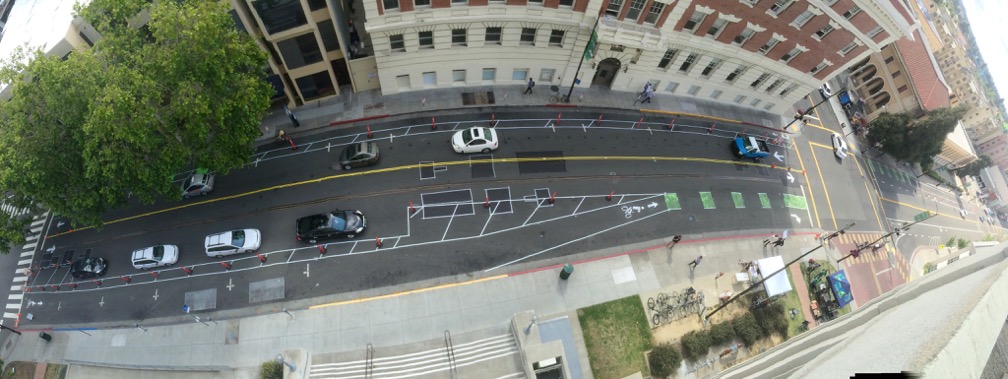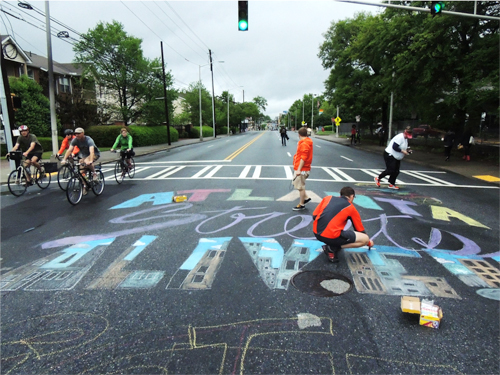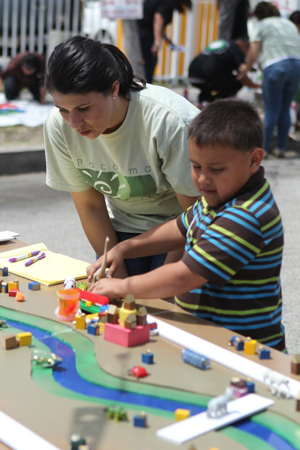Temporary biking and walking infrastructure is a popular and effective way to build support for permanent street changes. One-day pop-up bike lanes during Open Streets events and guerrilla-style, unpermitted acts of “tactical urbanism” can change minds faster than any blueprint at a community meeting. On our June Distance Learning Webinar, Dave Campbell from Bike East Bay in California, Ian Sansom from the PEDS in Atlanta, Georgia, and Yvette Lopez-Ledesma from Pacoima Beautiful in California discussed how to make these pop-ups happen and how to then elicit enough buy-in from the community and public officials to make the pop-up permanent.
Note to Alliance members: The recording and extended tipsheet from this webinar are available in the Resource Library. Please log in to gain access to the Resource Library. Email This e-mail address is being protected from spambots. You need JavaScript enabled to view it if you have questions on how to log in.
Dave Campbell
Advocacy Director, Bike East Bay
Bike East Bay has done several pop-ups, sometimes in conjunction with Bike to Work Day. Here are two examples from Dave's presentation:
Telegraph Avenue: First from pop-up to permanent facility. Used a real time traffic display sign (borrowed from Public Works Department). The sign said “traffic merge right” and alternated to say “Bike to Work Day 2014.” Removed existing parking, and staged a parked car. Mayor Jean Quan rode a bikeshare bike on bike to work day. After the mayor road through, the Senior traffic engineer had an invite to attend and experience the pop-up. Senior planners also attended and watched how cars moved, pedestrians crossing the street. The City Council voted 9-0 in favor of a protected bikeway as designed by Bike East Bay.

Milvia Street (pictured above): Most aggressive effort, and located right in front of City Hall. Bike East Bay redid the whole street with lots of tape, paint, stanchions, signs. The pop-up included restriping the centerline with yellow duct table, taping over the existing centerline with black duct tape, using black tar paper to tape over road markings. The design took out parking on the north side, and included protected parking on the south. Bike East Bay also used white duct tape for the traffic lines and included lots of signage to direct cars and bicyclists. To stage this, Bike East Bay had to close the street for one hour to tape and paint everything, and invited the mayor, city manager, council members, local institution leaders to attend the event.
Supplies: Lots of tape (duct tape, traffic tape), spray chalk (must be scrubbed off when the pop-up is done), rubber mats, signs, cones, a-frames, plants / planter boxes, artwork (will depend on your goals – looking great or functioning great)
Planning: Get permission! Have a detailed timeline with milestones, and go over a plan with lead volunteers. You must be really organized, especially if you are closing traffic and sending volunteers out. Have a press release. Take great BEFORE and after photos, and be ready if important people are rolling through your pop-up. Best if you can do some of the items the day before, and then roll out on the morning off. Pop-ups should be up and down within one day. Be out there and monitor to see how the design is going. Take down is especially important. The city likes you to leave the street the way you found it. Spray chalk might need a deep scrubbing. Follow up and gather all of the great photos for your website and social media. Thank everyone, including volunteers. Follow up with key people who came and saw the pop-up.
Resources from Bike East Bay:Telegraph Video and How to Guide.
Ian Sansom
Program Manager, PEDS
PEDS was founded in 1996 as Metro Atlanta’s pedestrian advocacy organization. In 1999, PEDS held “Gone for a walk” to call attention for crosswalks, which are still in existence today. Margaret Mitchell inspired some of the first pop-up to permanent infrastructure in Atlanta.
 Key factors to make successful pop-ups:
Key factors to make successful pop-ups:
- Make use of existing events: Atlanta Streets Alive, an open streets event, has a built-in audience. When people are biking and walking these routes, they are seeing the built environment in a new perspective. 50% of participants are on foot.
- Address a need: More likely to be successful if they address a need, so the public may make a demand to make them permanent. “Safe Routes to Transit” is one of those needs because 3 out of 4 people walk to transit. Hard to ignore colorful crosswalks with fun designs through chalk. Paint by number crosswalks are popular – set out a box of chalk and let people color in or design their own crosswalks. Wanted to make use of bus shelters, so focused on crosswalks enthusiastic volunteers, $200 in chalk for 10-15 crosswalks.
- Utilize resources: Resources definitely help. Focusing on older adults. Received a grant from ARC to create pop-ups. Created own bus shelters. Made a fun bus shelter / swing set. Created temporary bus stops that can still be seen around town. A little bit of funding can go a long way (artists to help create places of impact).
- Get transit agencies and municipalities on board: Easy to get pop-ups become permanent if the powers that be are involved. MARTA is looking for pop-ups to transform their downtown stations; downtown BID is looking for pop-up shops at vacant spaces along the new streetcar route; pop-up road diet with traffic cones to help build community support and evaluate a project.
Yvette Lopez-Ledesma
Deputy Director, Pacoima Beautiful
 Pacoima Beautiful is a environment justice organization located in the Los Angeles metropolitan region. The community is surrounded by three freeways, landfills, small commuter airport with flight paths over homes, and industrial sites. Pacoima has high rates of childhood obesity, asthmas, few parks for local residents.
Pacoima Beautiful is a environment justice organization located in the Los Angeles metropolitan region. The community is surrounded by three freeways, landfills, small commuter airport with flight paths over homes, and industrial sites. Pacoima has high rates of childhood obesity, asthmas, few parks for local residents.
The work at Pacoima Beautiful is led by community members, and works to ensure that the community can get their fair share of resources. Staff work with community members to identify areas for green space, parklets, plazas, etc. Community also identified areas for open area markets, programming. Youth also get involved, but the entire community – young and old – all want vibrant spaces to engage with friends and have areas they can get pride in.
The LA Department of Transportation was accepting applications for community groups to create plazas and parklets. First thought of a network of parklets along a major corridor, but the speed was too fast on that corridor – took a look at feedback and decided to look for underutilized streets that could be transformed. Identified Bradley Avenue that’s along the major corridor, near an alley by public housing, and was mostly used for parking.
Process:
- Visited the site on a frequent basis, met with local businesses, the housing authority, the police department, etc.
- Held community meetings to build support.
- Held a one-day pop-up to show the community what the plaza could be, and receive feedback from the community. Partnered with other local orgs to help - Held a bike clinic, mock farmers market.
- Developed a model to help visioning for nearby projects. Gathered feedback on plaza furniture via dot voting. Hired a local muralist to paint a map.
- The plaza today is not yet complete. Ground has been painted; the furniture is on its way, with a ribbon cutting in July. Having events such as meetings, zumba classes, bike clinics, and partnering with other orgs to host events.
Note to Alliance members: The recording and extended tipsheet from this webinar are available in the Resource Library. Please log in to gain access to the Resource Library. Email
This e-mail address is being protected from spambots. You need JavaScript enabled to view it
if you have questions on how to log in.

